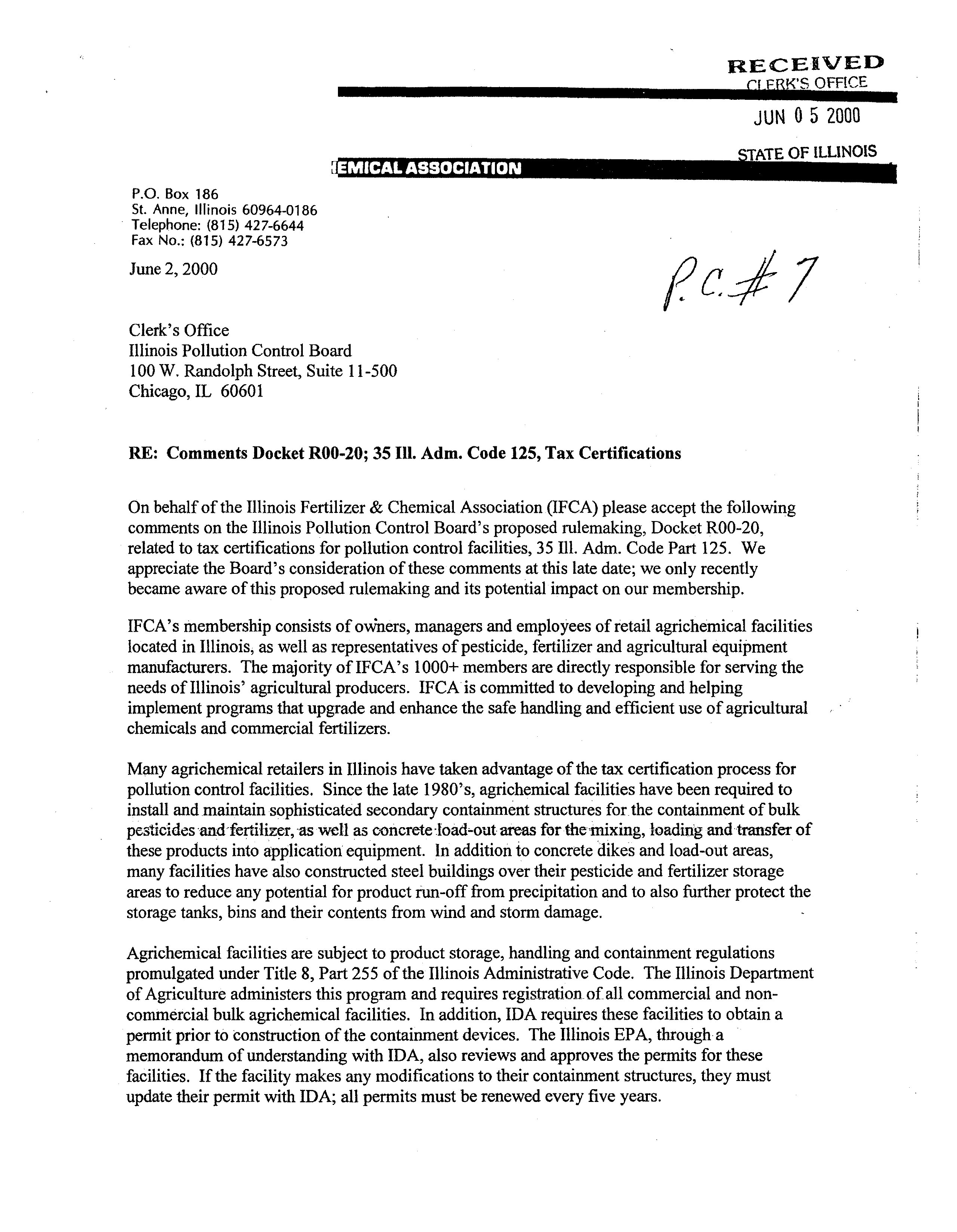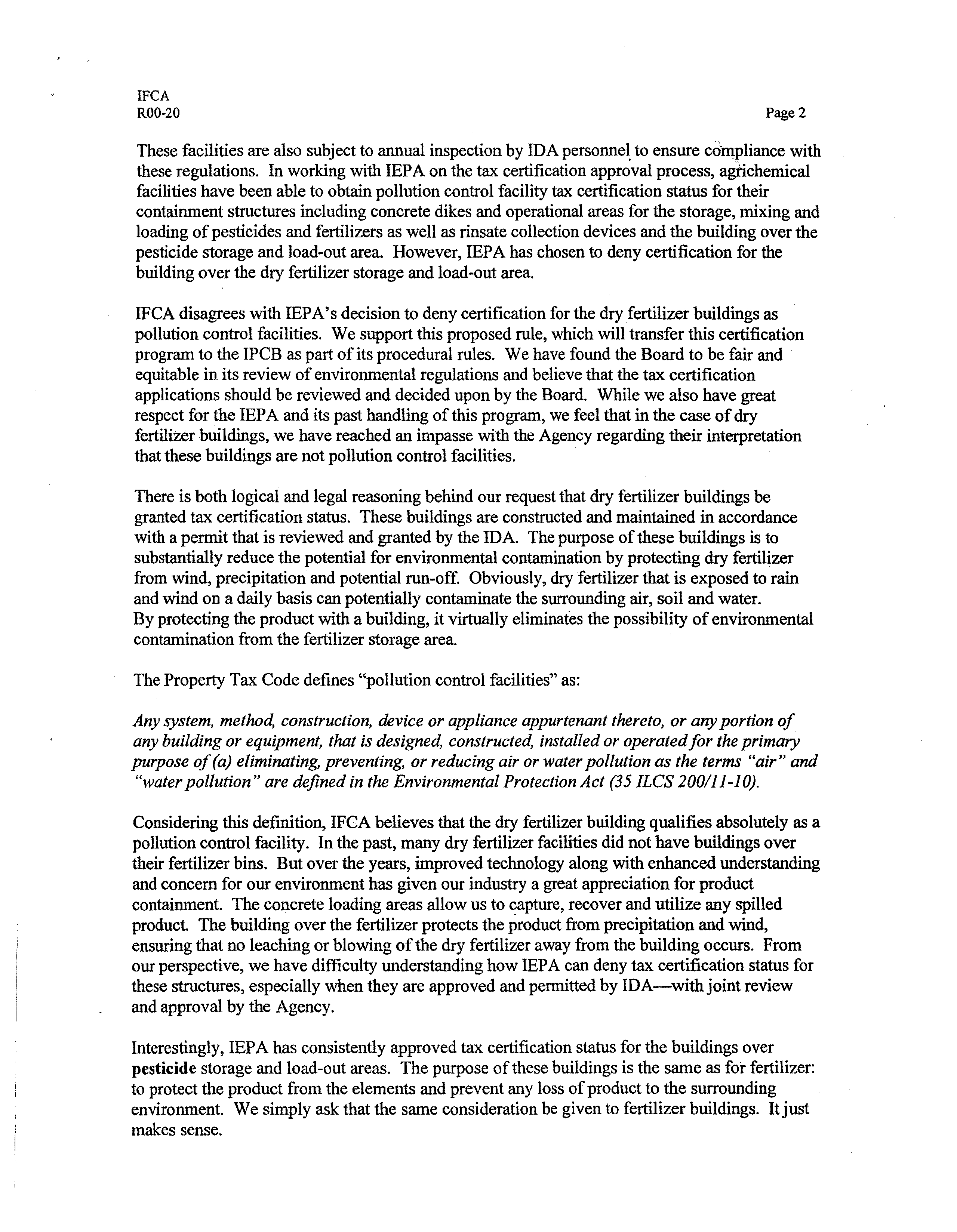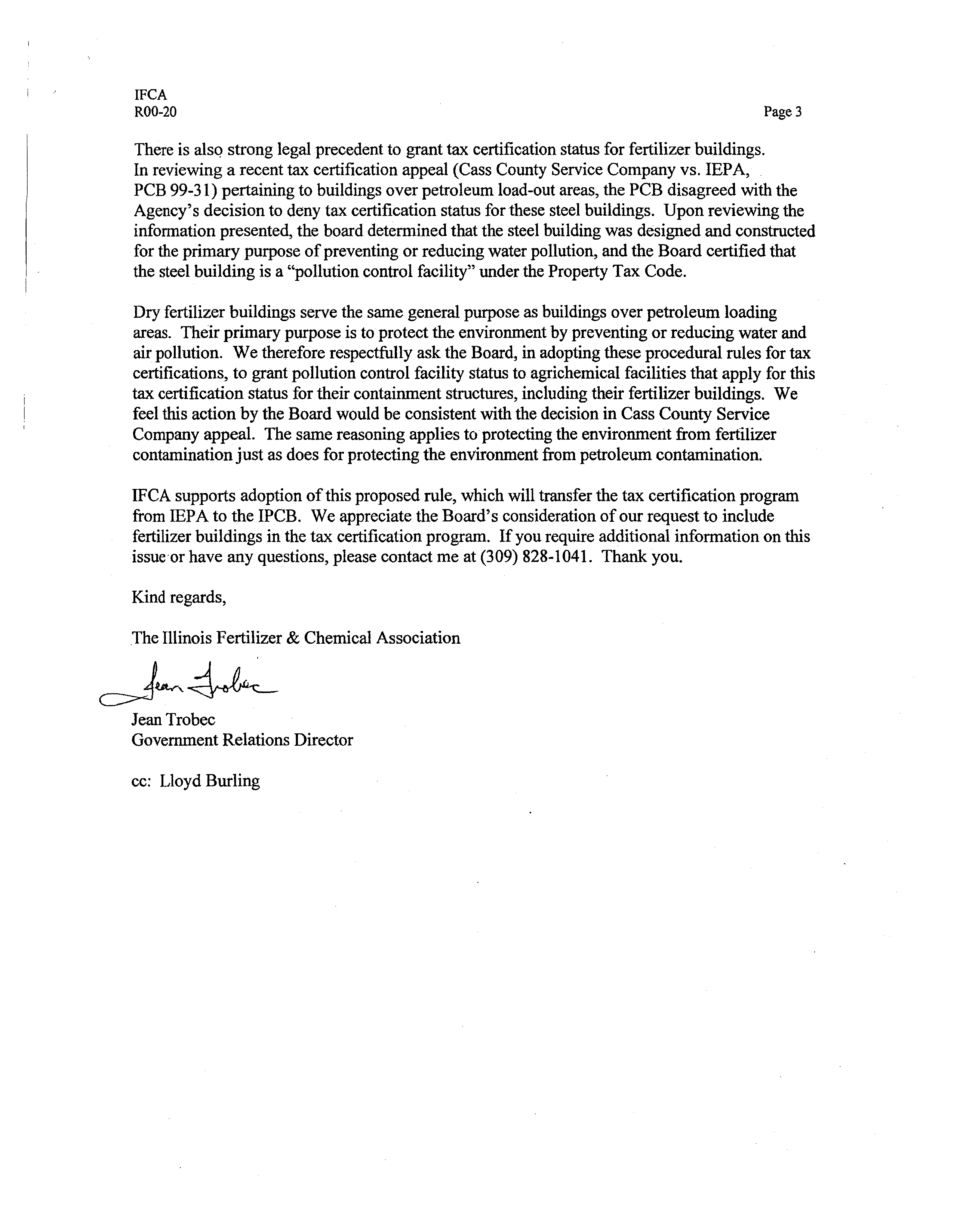RECEIVED
rr
FRK’S
OFFICE
JUN
052000
~STATEOF tLUNOIS
~~4~d~.1~~
Wi~TT.NT.1
E
a
I~
P.O.
Box
186
St.
Anne,
Illinois
60964-0186
Telephone:
(815) 427-6644
Fax No.:
(815) 427-6573
June 2, 2000
(V ~
,7
Clerk’s Office
Illinois Pollution
Control Board
100W. Randolph Street, Suite 11-500
Chicago, IL
60601
RE:
Comments Docket ROO-20; 35
Iii. Adm. Code
125,
Tax
Certifications
On behalfofthe Illinois Fertilizer & Chemical Association (IFCA) please accept the following
comments on the Illinois Pollution Control Board’s proposed rulemaking, Docket R00-20,
related to tax certifications for pollution control facilities,
35
Ill. Adm. Code Part 125.
We
appreciate the Board’s consideration ofthese comments at this late date; we only recently
became aware ofthis proposed rulemaking and its potential impact on our membership.
IFCA’s membership consists ofowners, managers and employees ofretail agrichemical facilities
located in Illinois, as well asrepresentatives ofpesticide, fertilizer and agricultural equipment
manufacturers.
The majority ofIFCA’s
1000+ members are directly responsible for serving the
needs ofIllinois’ agricultural producers.
IFCA is committed to developing and helping
implement programs that upgrade and enhance the safe handling and efficient use ofagricultural
chemicals and commercial
fertilizers.
Many agrichemical retailers in Illinois have taken advantage ofthe tax certification process for
pollution control facilities.
Since the late
1980’s, agrichemical facilities have been required to
install and maintain sophisticated secondary containment structures for the containment of bulk
pestic1des and fertilizer, as well as concrete load-cit areas for themixing, loading and transferof
these products into application equipment.
In addition to concrete dikes and load-out areas,
many facilities have also constructed steel buildings over their pesticide and fertilizer storage
areas to reduce any potential for product run-offfrom precipitation and to
also further protect the
storage tanks, bins and their contents from wind and storm damage.
-
Agrichemical facilities are subject to product storage, handling and containment regulations
promulgated under Title 8, Part 255 ofthe Illinois Administrative Code.
The Illinois
Department
ofAgriculture administers this program and requires regislration ofall commercial and non-
commercial bulk agrichemical facilities.
In addition, IDA requires these facilities to obtain a
permit prior to construction ofthe containment devices.
The Illinois EPA, through a
memorandum of understanding with IDA, also reviews and approves the permits for these
facilities.
Ifthe facility makes any modifications to their containment structures, they must
update their permit with IDA; all permits must be renewed every five years.
IFCA
R0O-20
Page 2
These facilities are also subject to annual inspection by IDA personnel to ensure compliance with
these regulations.
In workingwith IEPA on the tax certification approval process, agrichemical
facilities have been able to obtain pollution control facility tax
certification status for their
containment structures including concrete dikes and operational areas for the storage, mixing and
loading ofpesticides and fertilizers as well as rinsate collection devices and the building over the
pesticide storage and load-out area.
However, IEPA has chosen to deny certification for the
building over the dry fertilizer storage and load-out area.
IFCA disagrees with IEPA’s decisionto deny certification for the dry fertilizer buildings as
pollution control facilities.
We support this proposed rule, which will transfer this certification
program to the IPCB as part ofits procedural rules.
We have found the Board to be fair and
equitable in its review ofenvironmental regulations and believe that the tax certification
applications should be reviewed and decided upon by the Board.
While we also have great
respect for the IEPA and its past handling ofthis program, we feel that in the case ofdry
fertilizer buildings, we have reached an impasse with the Agency regarding their interpretation
that these buildings are not pollution control facilities.
There is both logical and legal reasoning behind ourrequest that dry fertilizer buildings be
granted tax certification status.
These buildings are constructed and maintained in accordance
with a permit that is reviewed and grantedby the IDA.
The purpose ofthese buildings is to
substantially reducethe potential for environmental contamination by protecting dry fertilizer
from wind, precipitationand potential run-off.
Obviously, dry fertilizer that is exposed to rain
and wind on a daily basis can potentially contaminate the surrounding air, soil and water.
By protecting the product with a building, it virtually eliminates the possibility of environmental
contamination from the fertilizer storage area.
The Property Tax Code defines “pollution control facilities” as:
Anysystem, method,
construction, device or appliance appurtenant thereto, or any portion of
any building or equipment,
that is designed, constructed, installed or operatedfor theprimary
purpose of(a) eliminating, preventing,
or reducingair orwater pollution as the terms “air” and
“waterpollution” are defined in the Environmental Protection Act (35 ILCS 200/11-10).
Considering this definition,
IFCA believes that the dry fertilizer building qualifies absolutely as a
pollution control facility.
Inthe past, many dry fertilizer facilities did not have buildings over
their fertilizer bins.
But over the years, improvedtechnology along with enhanced understanding
and concern for our environment has given our industry a great appreciation for product
containment.
The concrete loading areas allow us to capture, recoverand utilize any spilled
product
The building over the fertilizer protects the product from precipitationand wind,
ensuring that no leaching or blowing of the dry fertilizer away from thebuilding occurs.
From
ourperspective, we have difficulty understandinghow IEPA can deny tax certification status for
these structures, especially when they are approved and permitted by IDA—with joint review
and approval by the Agency.
Interestingly, IEPA has consistently approved tax certification status for the buildings over
pesticide storage and load-out areas.
The purpose ofthese buildings is the same as for fertilizer:
to protect the product from the elements and prevent any loss ofproductto the surrounding
environment.
We simply ask that the same consideration be given to fertilizer buildings.
It just
makes sense.
IFCA
R00-20
Page
3
There is also strong
legal precedent to grant tax certification status for fertilizer buildings.
In reviewing a recent tax certification appeal (Cass County Service Company vs. IEPA,
PCB 99-31) pertaining to buildings over petroleum load-out areas, the PCB disagreed with the
Agency’s decision to deny taxcertification status for these steel buildings.
Upon reviewing the
information presented, the board determinedthat the steel building was designedand constructed
for the primary purpose ofpreventing or reducing water pollution, and the Board certified that
the steel building is a “pollution control facility” under the Property Tax Code.
Dry fertilizer buildings serve the same general purpose as buildings over petroleum loading
areas.
Theirprimary purpose is to protect the environment by preventing or reducing water and
air pollution.
We therefore respectfully askthe Board, in adopting these procedural rules for tax
certifications, to grant pollution control facility status to agrichemical facilities that apply for this
tax certification status fortheir containment structures, including their fertilizer buildings.
We
feelthis action by the Board would be consistent with thedecision in Cass County Service
Company appeal.
The same reasoning applies to protecting the environment from fertilizer
contaminationjust as does forprotectingthe environment from petroleum contamination.
IFCA supports adoption ofthis proposed rule, which will transfer the tax certification program
from IEPA to the IPCB.
We appreciate the Board’s consideration ofour request to include
fertilizer buildings in thetax certification program.
Ifyou require additional information on this
issueor have any questions, please contactme at(309) 828-1041.
Thank you.
Kind regards,
The Illinois Fertilizer & Chemical Association
Jean Trobec
Government Relations Director
cc:
Lloyd Burling




